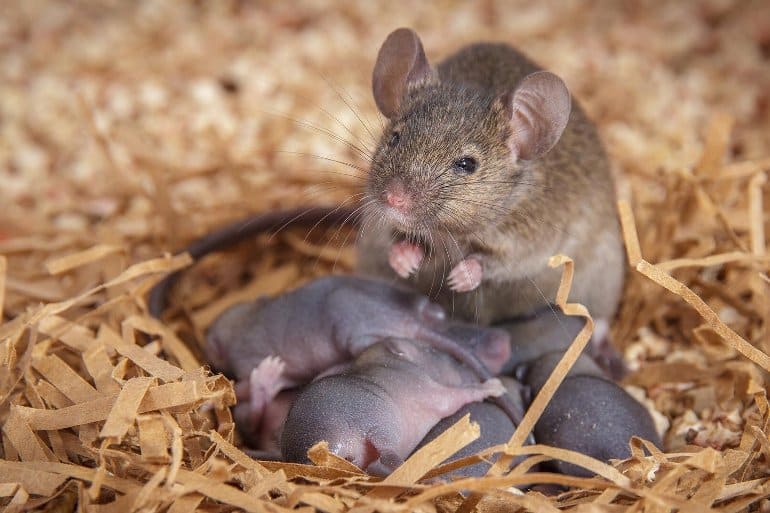Summary: Neuron activity in the locus coeruleus spikes when a mother mouse touches her pup to retrieve it.
Source: CSHL
The image of a mouse mom fetching her pup safely home calls to mind a human mother’s rapid response when their toddler wanders toward danger. Neuroscientists at Cold Spring Harbor Laboratory (CSHL) now report this resemblance applies in more ways than one.
In a first-of-its-kind study, postdoctoral fellow Roman Dvorkin and CSHL Associate Professor Stephen Shea were able to time this maternal caring action precisely to the firing of cells in a tiny brain region called the locus coeruleus, or LC, which is a blue cluster of cells found in the brainstem of all vertebrates. Dvorkin says:
“In nature, the pup when it grows, it starts to roll out of the nest, and the mother has to run and bring it back, otherwise it will either die from hypothermia or somebody will just eat it like a snack.”
Shea’s lab is a leader in studying maternal caring behaviors by observing female mice in settings that let them behave as they do in nature, as opposed to artificial, “contrived” experiments. “We study pup retrieval because it’s very reliable and it’s done the same way every time,” says Shea.
The team wanted to look at LC’s role in pup-retrieval because, “although LC is a very small fraction of the brain, it’s the brain’s sole source of a chemical called noradrenaline (NA), and it projects it throughout the whole brain,” Shea says.
NA is commonly known as the body’s fight-or-flight chemical. In the brain, LC is known to affect key functions like sleep and wakefulness, decision-making and memory, and emotional experiences like stress and arousal.

“But,” says Shea, “what we didn’t know is what activity it has during social behavior.”
Their findings are striking. The recordings show LC neurons spike in activity at the exact moment a mom touches a pup to retrieve it. “This very precise burst activates all of LC at one time. It sends this information across the brain and we think helps coordinate pup retrieval,” Dvorkin says.
Scientists know LC is important in human disorders that impair social functioning, including depression, anxiety, and autism. Studying the structure at this basic level could help reveal causes of such disorders and lead to potential new treatments.
About this behavioral neuroscience research news
Author: Press Office
Source: CSHL
Contact: Press Office – CSHL
Image: The image is credited to Roman Dvorkin/Shea lab/CSHL, 2022
Original Research: Closed access.
“Precise and pervasive phasic bursting in locus coeruleus during maternal behavior in mice” by Roman Dvorkin et al. Journal of Neuroscience
Abstract
Precise and pervasive phasic bursting in locus coeruleus during maternal behavior in mice
The noradrenergic locus coeruleus (LC) mediates key aspects of arousal, memory, and cognition in structured tasks, but its contribution to naturalistic behavior remains unclear. LC activity is thought to multiplex distinct signals by superimposing sustained (‘tonic’) firing patterns reflecting global brain states, such as arousal and anxiety, and rapidly fluctuating (‘phasic’) bursts signaling discrete behaviorally significant events.
Manipulations of the LC noradrenergic system broadly impair social behavior, but the temporal structure of LC firing and its relationship to social interaction is unknown. One possibility is that tonic firing may increase in the presence of social partners; it is also possible that phasic bursts may accompany specific social events.
We used chronic in vivo electrophysiology and fiber photometry to measure single unit and population neural activity in LC of freely behaving mice during their interactions with pups.
We find that pup retrieval elicits remarkably precise phasic activity in LC that can’t be attributed merely to sensory stimuli, motor activity, or reward. Correlation of LC activity with retrieval events shows that phasic events are most closely related to specific subsequent behaviors.
The reliability and magnitude of phasic responses strongly suggest that these events are coordinated across LC and broadcast NA release throughout the brain. We also observed slow changes in tonic firing when females performed distinct maternal behaviors such as nest building and pup grooming.
We therefore propose that LC signals state changes during sustained interactions and contributes to goal-directed action selection during social behavior with globally-broadcast NA release.







